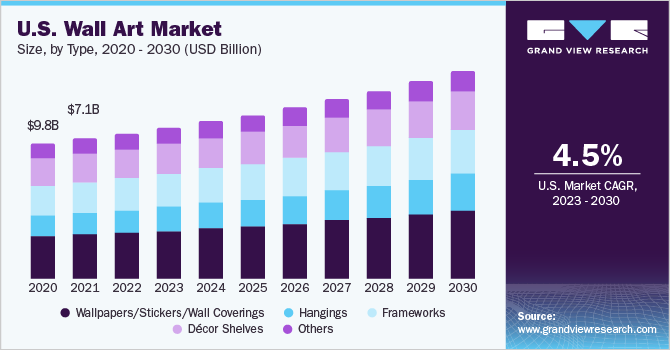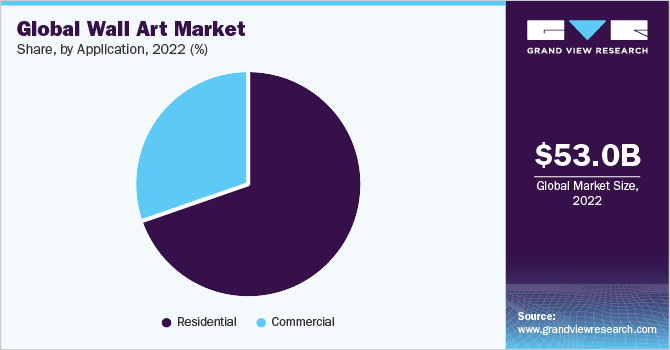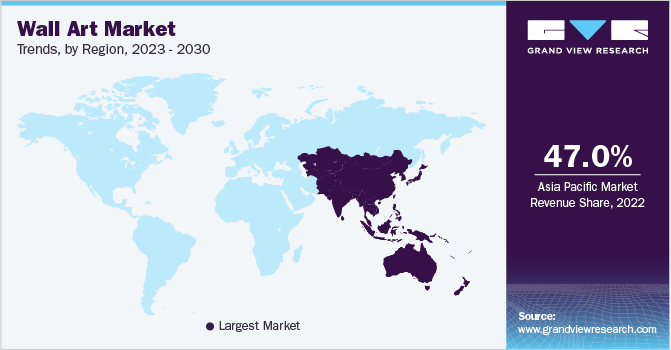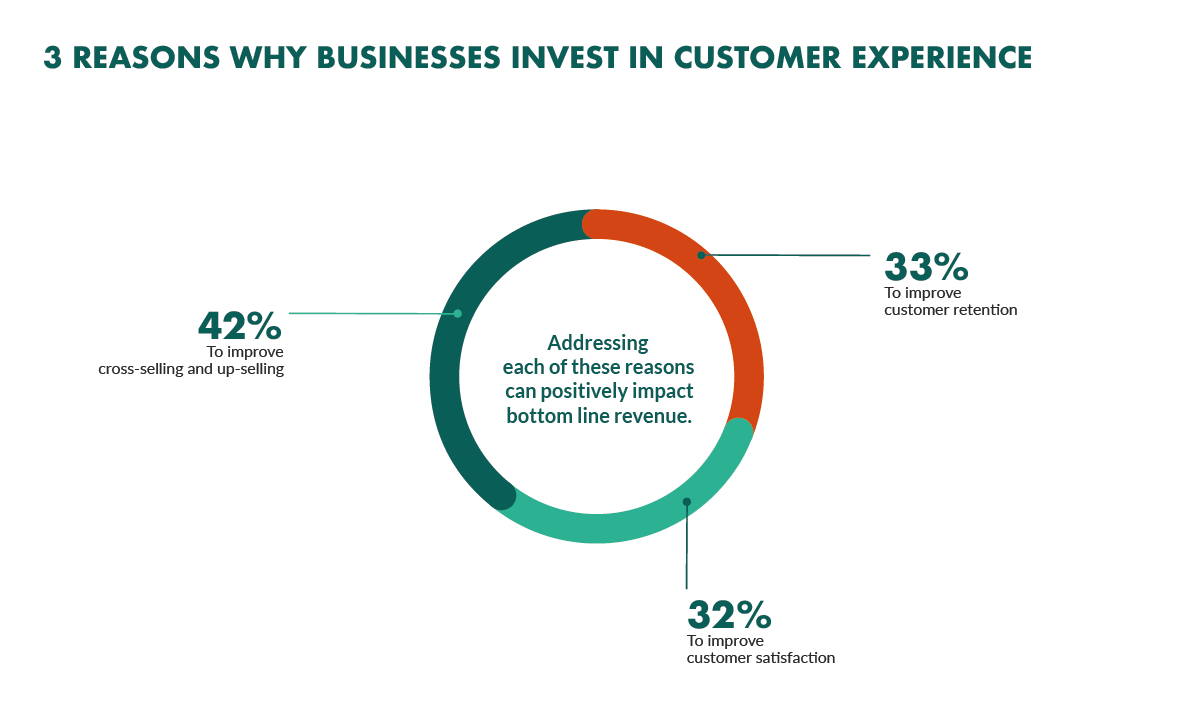Now is the time for newcomers to consider opening an art gallery of their own. The compound annual growth rate is projected at 8% from 2022 to 2025.

Art galleries play a critical role in connecting talented artists with art enthusiasts and collectors interested in purchasing original pieces. Not only can gallery owners profit from sales commissions and consignments, but additional revenue can be made by renting out gallery space for special events.
This guide explains how to open a art gallery. Topics include market research, competitive analysis, registering an EIN, forming an LLC, opting for business insurance, and even sourcing equipment. For everything you need to know to open your own gallery, read along.
1. Conduct Art Gallery Market Research
Market research is essential to starting a successful art gallery, art fair, or pop-up gallery. It helps you better understand the art world, competitors in the art community, your potential customers, and where to find the best art gallery location.

Some details you’ll learn through the art world market research as a gallery owner include:
- Consumer spending on the visual arts has been rising steadily over the past five years.
- Discretionary income levels directly impact demand.
- As prosperity increases, more people have budgets allowing them to spend thousands or even millions acquiring fine art for their homes, offices, or as financial assets.
- The top 20% of earners account for over 85% of art buyers in the US.
- Besides end consumers, businesses also fuel gallery revenue through corporate art purchases to decorate their establishments and construct unique office environments.
- While existing brick-and-mortar galleries possess the majority share, eCommerce is making the market more accessible industry-wide.
- Online art sales are rapidly rising as collectors discover emerging artists and bid electronically.
- Auction houses like Christie’s and Sotheby’s have robust online bidding and consigning platforms as well.
- Aspiring gallerists can launch digital storefronts with minimal overhead costs compared to physical gallery space.
- Local galleries retain advantages by building intimate artist and buyer relationships not easily replicated online.
Localized markets across the country present entry points for new startups focused specifically on domestic buyers in their geographic area versus prestige worldwide clientele. While scaling globally poses challenges, cultivating a committed regional following can steadily build a profitable gallery brand over the first five years and beyond.
And not only that; art is both highly subjective and highly objective. Art galleries are known for organizing events that focus on a specific type of art, such as stickers, performances, crafted items & art, and more. This sort of approach can be very interesting to a large group of people and is worth considering.
2. Analyze the Competition
Analyzing the competition is crucial when launching a successful gallery, whether in physical or online form. Thoroughly researching competing galleries in your local area and wider market reveals key opportunities to differentiate and build market share.

Some ways to learn more about local competitors include:
- Identify direct brick-and-mortar rivals with premises near your ideal locations.
- Walk through these spaces, study their designs, and note price points for various artists to gauge market rates. Talk to gallerists about the history of that area’s art scene.
- Look at the mix of emerging talent and established names they exhibit and sell; this informs your artist acquisition strategy.
- Compile a competitor matrix showing each gallery’s strengths and weaknesses on factors like customer service, events/programming, and refresh rate of new pieces. Use this intel to position your value.
- Expanding beyond physical foot traffic, audit the online performance of competitors.
- Scrutinize their website quality, SEO tactics driving discoverability, and social media follower counts.
- Sign up for email lists to analyze engagement messaging and special offers.
- Note how often new content gets published across blogs/newsletters highlighting exhibited works and artists.
- Competitive analysis uncovers gaps in the business community to build market share, such as cultivating an Instagram audience before launch for immediate digital visibility.
- Research aggregators like Artsy and Artnet provide global visibility for millions of works in all mediums, styles, and price brackets.
- Large marketplaces host smaller galleries and independent established artists in the business world too.
- Monitoring wider industry digitalization spots where niche opportunities exist for your regional gallery interests amid lots of “noise” online.
- Combine physical immersion and digital reach in your go-to-market strategy.
Ongoing analysis as new players emerge builds business resilience. Put monitoring systems in place to regularly revisit other galleries and check their activity year-round.
3. Costs to Start an Art Gallery Business
Starting an art gallery requires a substantial upfront investment to secure a venue, purchase assets, and fund pre-opening preparations. you’ll also encounter ongoing costs to keep your art gallery afloat. Let’s take a closer look at how these business expenses stack up.
Start-up Costs
Total start-up costs typically range from $50,000 to $150,000. Exact budgets vary based on gallery size, location, and specialty.
- Leasing appropriate gallery real estate is a significant expense, ranging from $5,000 to $25,000 monthly depending on size and area rents.
- Necessary improvements like lighting installations, display anchors, and even minor renovations can cost $5,000 to $30,000 upfront.
- Building customizable walls alone runs $10 to $15 per square foot. Consider the necessary square footage and layout to properly exhibit your focus on fine art.
- Investing in assets to display and store art usually requires $10,000 to $20,000 upfront for specialized equipment like pedestals, frames, hanging systems, storage racks, and inventory software.
- Archival storage materials are crucial for protecting work. Security enhancements like camera systems and sensors average another $3,000.
- Further, fixed startup costs include licensing and insurance expenses before opening. General business liability coverage averages $2,400 annually for galleries.
- Additional fine arts insurance protecting high-value pieces or coverage for art while in transit may cost over $5,000 annually. City business permits, reseller permits, and sales tax registration carry some nominal fees as well.
- Pre-launch costs for establishing gallery branding range from $1,000 to $5,000 factoring logo design, basic website, and print collateral like business cards, and client info packets.
- Allocate a separate marketing budget for advertising, search engine visibility, and initial promotions to drive early buyers. Consider offering discounted “Friends & Family” memberships.
- Opening inventory represents one of your largest startup investments, funded through small business loans or crowdsourcing.
- Emerging artist’s price points start around $500 to $2,500 per piece, while established names run up to millions.
- Conservatively budget $20,000 to $30,000 to stock 25+ pieces across styles and mediums so walls never look empty. Limited runs of affordable prints also generate volume sales.
Ongoing Costs
Once the doors open, ongoing monthly costs start with staff payroll, insurance, utilities, and mortgage or rent payments.
- Employees typically cost $3,000 and up monthly.
- Other variable operating expenses include costs per exhibition like shipping fees, event catering, advertising, and pr.
- Budget several thousand monthly for rotating inventory acquisition as well.
- Marketing expenses to maintain digital visibility and relationships with collectors add up to $20,000-plus annually.
- Consider bringing overhead costs down by starting small and then expanding gallery reach over time.
With careful financial planning and execution, art galleries can turn profits within a few years. But be prepared for thin margins initially while building reputation and pipeline.
4. Form a Legal Business Entity
When starting an art gallery, the legal structure chosen impacts owner liability, taxation, and long-term flexibility to add partners or investors. While sole proprietorships and partnerships offer simpler tax scenarios for new ventures, limited liability protection should be a top priority given the high-value artwork involved.
Sole Proprietorship
Sole proprietorships provide zero liability separation, with the business owner personally responsible if sued over art damages, unable to repay debts or leases or hit with employee lawsuits. Their taxes get filed via Schedule C personal returns with income directly taxed under the owner’s rate. Administrative needs are simpler without needing a separate EIN or legal formalities like annual meetings.
Partnership
Partnerships allow co-owners to pool resources and bond together to bankroll a gallery using an IRS Form 1065 for taxes. However multiple founders split profits evenly despite unequal capital investments, causing potential conflict. All partners also take on joint and several liability for debts and legal issues.
Limited Liability Company (LLC)
Forming an LLC shields personal assets in business lawsuits given the separate legal identity apart from individual owners. Taxes get handled similarly as partnerships through individual returns for profits passed through, avoiding double taxation issues with corporations. LLC operating agreements allow customized allocation of financial and managerial interests.
Corporation
A corporation is the most secure for businesses hoping to protect personal assets. They’re also the most complex to register, and the most costly. Corporations are best suited to large businesses, or small businesses looking to expand or open secondary or tertiary branches.
5. Register Your Business For Taxes
An Employer Identification Number (EIN) serves as a unique tax ID number for business entities to identify themselves to the IRS and other government agencies. Art galleries should apply for an EIN even if they do not plan to hire employees right away.
An EIN is required to open business bank accounts, apply for licenses, file taxes properly each year, and more crucial administrative functions.
Thankfully obtaining an EIN takes just minutes online. Simply navigate to the official IRS EIN Assistant tool and follow the short application. You will need basic information like official business name, address, industry classification code for “art dealers” (45392), and responsible party details tied to the gallery’s ownership structure.
Double-check entries to avoid errors before submitting. After approval, your EIN gets displayed on the screen to save for later use on necessary tax documents. Expect to receive an IRS confirmation notice in the mail within 4 weeks too.
Remember that sales tax obligations extend to your specific state and city for galleries selling retail products. After securing your federal EIN, visit your State Tax Department website to apply for required sales tax permits. These certificates allow the collection of mandatory state and local sales taxes from buyers on art purchases.
The sales tax registration process only takes minutes as well. You will need to provide new details like projected monthly and annual gallery revenue estimates which determine reporting frequencies.
Approvals finalized instantly provide certificates to prominently display on premises next to checkout areas. Ensure accounting software or point-of-sale systems are configured for automatically calculating precise sales tax rates at the time of ringing up sales. Periodically remit collected taxes by filing schedules, usually quarterly or annually.
6. Setup Your Accounting
Robust accounting practices are essential for art galleries to track high-value inventory, sales, and expenses across potentially numerous vendor and client relationships. Investing in organizational accounting infrastructure from day one alleviates stressful financial headaches as operations grow.
Accounting Software
Begin by implementing small business accounting software like QuickBooks to establish centralized digital systems for handling bookkeeping, invoicing, and reporting. Connect integrated payment processing to automatically populate gallery sales and credits tied to artwork. Sync business bank and credit card accounts to fetch transaction data.
Hire an Accountant
Experienced accounting professionals afford invaluable direction on maximizing write-offs from start-up costs, tracking the cost of goods sold across varying inventory price points, and staying tax-compliant across state lines for art sales. Expect to invest around $200 per month for routine bookkeeping assistance, reconciliation, and sales tax preparations.
Open a Business Bank Account
Strictly separating all personal and business finances preserves order. Open a dedicated business checking account and credit card solely for art gallery use to simplify reporting. As a newly registered LLC entity, providers can issue company cards based on your firm’s financial profile versus personal credit score. This facilitates higher limits from the get-go. Pay off balances monthly.
7. Obtain Licenses and Permits
Before opening gallery doors, owners must research and obtain all necessary paperwork sanctioning retail art sales and public assembly in their region. Find federal license information through the U.S. Small Business Administration. The SBA also offers a local search tool for state and city requirements.
First, contact your city planning department about securing a standard business license verifying zoning allowances for a commercial art gallery at your desired location. Some municipalities limit certain types of businesses within designated districts.
The business license application submissions themselves mandate pre-approvals related to gallery premises like proper fire exits, occupancy capacities, disability access compliance, and even parking minimums. Navigating this bureaucratic process early flags any issues needing to be addressed per local codes.
While zoning pre-approvals help ensure suitable gallery real estate, owners leasing spaces also need permission from landlords through an official lease agreement contract. Negotiate terms allowing business activities like installing customized display anchor holes in walls to properly hang heavy artworks.
Managing product inventory also potentially requires special licensing. Galleries selling limited editions of prints alongside original framed works should confirm city statutes related to print production. Some regions restrict printer possession without print production licenses. Stay compliant by outsourcing production orders through vendors.
Similarly, art galleries occasionally host public events like artist meet-and-greets or corporate rentals to generate added revenue. Serving alcohol requires both state liquor licensing and local permits per municipality capped at a defined attendee occupancy.
While exhausting to pinpoint art gallery permits needed across jurisdictions, particularly for those galleries operating across multiple regions, staying legally compliant protects long-term viability. Connect with government departments early outlining intended activities to identify required approvals before launch.
8. Get Business Insurance
Given art galleries trade in extremely valuable and vulnerable fine artwork inventory, owners absolutely must safeguard assets and mitigate risks through specialty business insurance coverage. Without policies, a single incident could permanently destroy an uninsured gallery.
For instance, a failed AC system on a hot weekend could cause dangerous humidity swings damaging fragile works on paper. Conservators charge $3,000-plus per piece for restoration—a single show could result in $100,000 in damages.
Additionally, galleries frequently transport high-priced collections across state lines for special exhibitions, art fairs, or client meetings making appraisals more convenient. However, vehicles get into accidents, experience fires, or even get burglarized during pit stops.
Finally, embezzling employees or even guest art thieves with sly motives could successfully steal displayed artwork during open hours or special events. Inventory disappears quickly for resale on black markets without video proof.
To secure appropriate art gallery insurance, reference resources at industry trade associations like the Art Dealers Association of America or Association of International Photography Art Dealers which list approved brokerages. Expect to pay around $2,400 annually for robust property, liability, and loss of income protections across common risks.
When contacting brokerages, prepare details like the average number of visitors per month, the average value of the entire collection, transit needs, and off-site exhibiting plans. Expect on-site assessments of security systems too.
9. Create an Office Space
Carving out administrative office areas within art galleries provides owners and staff with space to handle crucial business. Dedicated backroom desks facilitate tasks like preparing exhibition literature, planning opening evening events, and processing sales transactions.
On-Site Office Space
When first launching on tight budgets, galleries can optimize unused basement or second-floor space as makeshift offices at no added overhead costs. Minimal build-outs for electrical, lighting, and internet connectivity likely still cost around $5,000. Additionally, remotely located offices prove inconvenient for staff continually needing to transit to access files, supplies, and equipment located in disparate areas.
Commercial Office
For larger teams or special departmental needs, leasing basic commercial office space within nearby buildings starts at around $20 monthly per square foot in most cities to establish offsite administrative hubs. While gaining workplace efficiencies, the distance separation from physical galleries proves a challenge for daily operations.
Coworking Office
To foster community, WeWork locations offer both shared coworking areas plus private office rentals across major metro markets. Unique site amenities like conference spaces, event hosting capabilities, and member networking events supplement traditional utilities and wifi. However, the dispersed geography may not best serve localized art gallery needs.
10. Source Your Equipment
Properly outfitting an art gallery with specialized display infrastructure allows spotlighting of fine works in an optimal setting that captivates visiting patrons. When reviewing myriad options, balance quality with affordability, particularly during start-up phases.
Buy New
Purchasing brand-new sell specialized gallery fixtures and racking from vendors allows customizing systems perfectly for showcasing specific collections. Frame shops like Frame Destination sell movable partition walls, adjustable picture hanging, pedestals, accent lighting, and reinforced storage units built to last decades. Products run $5,000 to $30,000 however for outfitting full spaces.
Buy Used
Buying quality used display assets through auction marketplaces like Artwork Archive or traditional consignment stores proves more economical. Search local inventory for pedestals, installation hardware, modular walls, and other essentials typically discounted 40% to 60% below original prices in lightly used condition.
Rent
Rent equipment short-term for special exhibitions or events through national chains like CORT Events which stocks furniture rentals in major regions. Contracting locally for a single week or month avoids consuming permanent floor space better used for displaying gallery owners’ long-term collections and direct artist consignments.
Leasing
Leasing agreements through peer galleries allow the sharing of underutilized assets across different locations. Create cooperative relationships with neighboring establishments to loan each other extra pedestals, vitrines, plinths, or other specialty items for a monthly rental fee. This facilitates more dynamic gallery layout options.
11. Establish Your Brand Assets
Cultivating a distinctive art gallery brand identity makes memorable first impressions on visiting patrons that resonate across repeated exposures over years as loyal customers. Investing in professional branding early on ensures your space makes the desired artistic statement among regional creative class consumers from day one.
Get a Business Phone Number
Centralizing communications under a single business phone number projects legitimacy across caller IDs for client outreach. Digital systems from RingCentral provide toll-free and local number options with customizable recorded greetings to start projecting a polished image.
Design a Logo
A logo and visual identity system creates an artistic brand signature for all marketing materials from business cards to shopping bags. Consider iconic marks evoking key emotions. Custom logo design services through Looka start under $100.
Print Business Cards
Print collateral like business cards, gallery brochures, and exhibition invitations should feature branding for brand reinforcement across touchpoints. Patrons appreciating a preview postcard are more likely to recall your icon when driving past new venues. Online printer Vistaprint offers affordable packaged branding suites for under $200 with free shipping.
Buy a Domain Name
Your domain name and website are central pillars when introducing new gallery brands digitally. Brainstorm names containing keywords like “art” while checking domain availability at registrars like Namecheap. Once purchased, direct the URL to even basic single pages or sites describing your vision.
Design a Website
While tempting to DIY sites through Wix site builders initially, complex e-commerce functionality for showcasing artists and processing sales merits hiring web developers found on freelance marketplaces like Fiverr starting around $500.
12. Join Associations and Groups
Engaging with both local artists and the national art industry associations proves invaluable for new gallery owners seeking insider knowledge for gaining regional footholds. Tapping into established networks in the art market offers marketing exposure, mentorship opportunities, and visibility during prestigious fine art fairs.
Local Associations
Chambers of Commerce provide community networking and promotional support for the creative class. Join subgroups like regional Art Councils connecting area galleries, or broader associations like Americans for the Arts covering issues across visual and performing arts nationwide. Pay reasonable annual dues in the $100-$500 range to access tools.
Local Meetups
Attend local art events announced on sites like Meetup to interface with fellow gallerists, artists, and collectors in your city. Discuss trends, buyer pain points, emerging platforms like NFTs, and potential partnerships with other art gallery owners and other art community members.
Facebook Groups
Right from launch, tap into Facebook’s hyper-targeted interest Groups like Art Gallery – Show your work! Oils, Acrylics, Watercolors, Pastels, and International Art and art Galleries. Use these connections in the local art scene to crowdsource answers for challenges like marketing, insurance, events, or gallery management software directly from thousands of peers already navigating similar learning curves in the field.
13. How to Market an Art Gallery Business
Implementing an omnichannel marketing strategy combining digital and real-world tactics is crucial for art galleries seeking to attract discerning patrons and build lasting relationships with art buyers. While digital tools offer targeting precision, traditional channels foster meaningful community connections. Balance both when raising regional visibility.
Personal Networking
Tap existing personal and professional networks to share news of your gallery’s opening. Early visitors provide critical word-of-mouth validation, and their enthusiastic Instagram shares, Yelp reviews and endorsement to friends support credibility as a reputable exhibition space for acquiring works. Incentivize referrals by providing 10% purchase discounts to anyone led there by a peer review.
Digital Marketing
- Claim Google My Business and Facebook Pages connecting your website to optimize local SEO and facilitate customer interactions.
- Run paid search and social media ads geo-targeted to drive foot traffic from neighborhoods with lots of creative class households.
- Tailor display creatives and captions around different collections or featured artists rather than static logos for more compelling messaging.
- On social media platforms, post Stories showcasing behind-the-scenes gallery preparations and highlight exhibited works using optimized alt text prompting algorithmic distribution to interested viewers.
- Collaborate with artists directly to repost their announcements of the representation to their fans.
- Consider a “Featured Artist of the Month” blog series interviewing represented talents and providing backstories enriching appreciation of their techniques and inspirations.
- Embed video studio visits for more intimate portrayals.
- Promote posts through email newsletter sponsorships and social media ads to boost ongoing engagement.
Traditional Marketing
- Traditionally, print exhibition postcard mailers to regional upper-class households make memorable first impressions with stellar graphic design.
- Partner with neighboring galleries, shops, and museums to distribute mutual flyers or arrange cross-promotional events introducing each other’s patrons to new creative Scene hubs.
- Plan select openings to coincide with existing arts festivals or gallery nights when external crowds heighten exposure.
- Provide festival sponsors’ booth visibility in exchange for public shoutouts alongside existing programming directing attendees specifically to your space.
While digital platforms present tremendous targeted reach capabilities, traditional channels foster genuine human bonds between galleries, artists, and trustee patrons substantiating reputations as respected curators. Blend both when raising regional art scene prominence.
14. Focus on the Customer
Providing incredible customer service proves crucial for art galleries to not only close initial sales but also secure returning patron visits while earning referrals and a coveted reputation among regional collectors. Invest in the entire art acquisition experience beyond just showcasing works on walls.

Some ways to improve customer focus include:
- Greet visiting guests promptly during open hours and gauge their artistic interests through casual conversation.
- Dedicate sincere time to familiarizing newcomers with diverse creators’ stories and techniques behind collections available for acquisition.
- Follow up post-visit with handwritten notes checking if they’d like any lingering questions answered from featured artists directly.
- Seek genuine feedback on exhibitions and events for improvement areas too.
- When buyers feel personally invested in versus merely sold to, they eagerly endorse galleries to friends planning local art outings.
- During subsequent visits, impress VIP patrons by remembering their aesthetic leanings and walk them directly to newly arrived paintings suited for their homes without prompting.
- Occasionally offer exclusive previews of works arriving next exhibition season.
Exceptional hospitality entrenching galleries as approachable conduits between talent and appreciators seeds lasting behavioral loyalty beyond one-off sales. Newfound evangelists voluntarily spotlight spaces carrying beloved artists’ future bodies of work.
